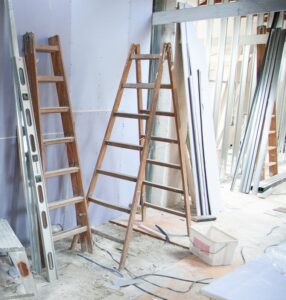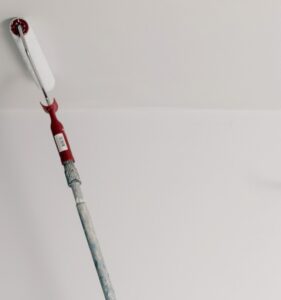The Painter’s Toolbox – What Makes a Painter a Professional
Posted by Brant Heritage Painting, Sunday, May 21st, 2023 | 840 views
 In the world of painting – like any skilled trade – the line between an amateur and a professional isn’t just about experience or certification. It’s also quite significantly defined by the quality of the tradesperson’s tools and their knowledge of when, why, and how to use them properly.
In the world of painting – like any skilled trade – the line between an amateur and a professional isn’t just about experience or certification. It’s also quite significantly defined by the quality of the tradesperson’s tools and their knowledge of when, why, and how to use them properly.
Here’s a brief look into the painter’s toolbox and a discussion on what truly makes a painter a professional.
The basics of the painter’s toolbox – paint brushes
Every professional painter’s toolbox starts with the basics – paint brushes, rollers, a paint-can opener and a few other important and useful tools. When it comes to ensuring a professional job is done, using the right paint brushes makes all the difference.
A painter’s set of brushes come in a large array of types, shapes and sizes, with each having its own specific purpose. Some brushes cut lines with precision while others are made to cover large surface areas. Rollers are crucial too . They speed up the painting process and ensure a smooth finish especially on larger surfaces areas like walls and ceilings.
Everyone can pick up a paint brush and start painting, but not everyone can use a paintbrush like a professional can in order to make a home look it’s best the first time it’s done.
What else is in a professional painter’s arsenal?
 The professional painter’s toolbox extends well beyond the basic tools like brushes and can openers. Other highly essential tools include:
The professional painter’s toolbox extends well beyond the basic tools like brushes and can openers. Other highly essential tools include:
The painter’s basic tools
- Putty knife: This versatile tool comes in various shapes and sizes and allows for more precision and control. It is used for various applications like applying and smoothing filler over holes, cracks, and other imperfections. It ensures that the final painted surface is smooth and seamless.
- Caulking guns: These tools are often used to fill gaps or cracks before painting, ensuring a smooth, seamless finish.
- Safety equipment: This includes safety glasses, work gloves, respirators or masks, and sometimes even protective clothing or footwear, depending on the job’s requirements.
- Ladders: Professional painters also use ladders for handling heights and hard-to-reach places.
- Paint scrapers: A paint scraper is useful painter’s tool for removing loose, cracked, or peeling paint from a surface before applying a new coat. This preparation step can be crucial in some situations and prevents the new paint from peeling and while giving a professional-looking finish. Scrapers come in various shapes and sizes to accommodate different surfaces and types of paint.
- Painters tape: Painter’s tape is vital for achieving sharp and clean edges around trim, windows, and doors, or when painting stripes or other creative designs. Painter’s tape is designed to block paint but be easily removed after the paint has dried.
- Drop cloths: Drop cloths are typically made of canvas, plastic, or some other absorbent material and spread over the area to protect it from drips or spills. Professional painters often have both types on hand for different situations.
- Paint trays and bucket screens: Paint trays are used with rollers to evenly distribute the paint, while bucket screens are hung inside paint buckets and allow excess paint to drip back into the bucket when using the roller. Painter’s buckets are also used for mixing liquids and cleaning other tools.
 Efficiency and accuracy tools
Efficiency and accuracy tools
- Tape measure: A tape measure is a tool that helps achieve precision and accuracy which are critical in the outcome of a professional paint job. It’s used to calculate the area to be painted, maintain consistent spacing for design elements, and helps align fixtures and decorations. A tape measure is a must-have in a painter’s toolbox.
- Paint sprayers: Most professional painters use paint sprayers, especially for outdoor projects or large indoor areas. They provide a smooth finish and come in several types, including airless sprayers, HVLP (High Volume Low Pressure) sprayers, and handheld sprayers.
- Extension poles: When needed, extension poles can attach to paint rollers or sprayers, allowing the painters to reach high up or other hard-to-access areas without jeopardizing safety and ensuring accuracy. The typical painter will have a number of extension poles on hand to use in various situations when needed.
- Painters multi-tool: This is an incredibly versatile tool that can be used as a scraper, a putty spreader, a paint can opener, a roller cleaner, and do a few more things that make the job more efficient.
- Heat guns or infrared paint removers: Professional painters often use these tools to speed up the process of removing old or peeling paint. When it comes time to completely remove paint from a wall these tools make the job much easier and the end result remains high quality.
- Sanding tools: Sandpaper or power sanders are used by professional painters to help smooth out rough surfaces, remove old paint or remove old putty.
- Masking machines: These machines make applying masking tape and paper or plastic sheeting much faster and easier. They’re particularly useful for large jobs but overall make the job run more smoothly and quickly.
The list of tools is bigger than you first though right? All of these tools – when combined with the right experience and skill set – contribute to creating professional work and ensuring they deliver the highest possible quality results.
So if you’re thinking of painting your home or commercial space yourself, you can try it yourself, but if you want to ensure a professional and long-lasting outcome, hire a professional painter.
Traits that make a painter a professional
 Perhaps a less tangible but equally important tool, are the painter’s eye for detail and an in depth knowledge of the different types of paint finishes and when to use them. The ability to accurately assess, prepare and finish a surface with the right type of paints and finishes produces a final outcome that really can’t be matched by a do-it-yourselfer.
Perhaps a less tangible but equally important tool, are the painter’s eye for detail and an in depth knowledge of the different types of paint finishes and when to use them. The ability to accurately assess, prepare and finish a surface with the right type of paints and finishes produces a final outcome that really can’t be matched by a do-it-yourselfer.
Painters with many years of experience know the importance of safety. They know when working with certain types of paint or in poorly ventilated areas that respirators should be worn Their safety toolbox generally includes safety goggles, gloves, and appropriate clothing, and they understand the value of keeping their workspace clean and organized to prevent accidents.
Most professional painters stay up to date with new latest techniques, materials, and equipment that improve the quality and efficiency of their work.
Should I paint my space myself, or hire a professional painter?
By now you’ve probably realized that the job of a professional painter takes a lot more than going to home depot and picking up a few supplies. A professional painter’s toolbox is filled with many physical tools, knowledge, and years of experience which lets them transform a house into a home or an office into the most welcoming workspace.
Not convinced? If you live in Brantford, we invite you to read about why you should hire a professional painter which will help you make an informed decision as to whether hiring a professional will better help you achieve the goals of your home or office painting project.
